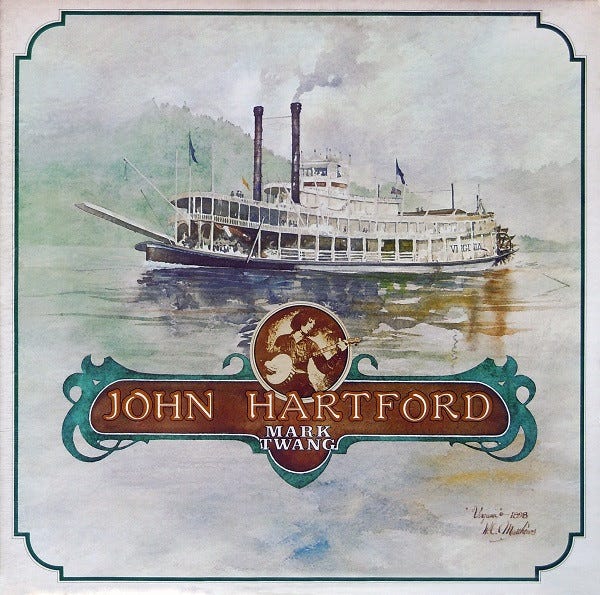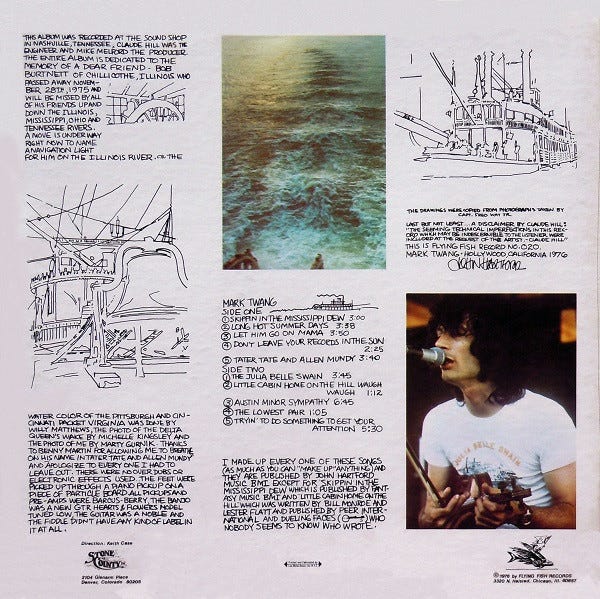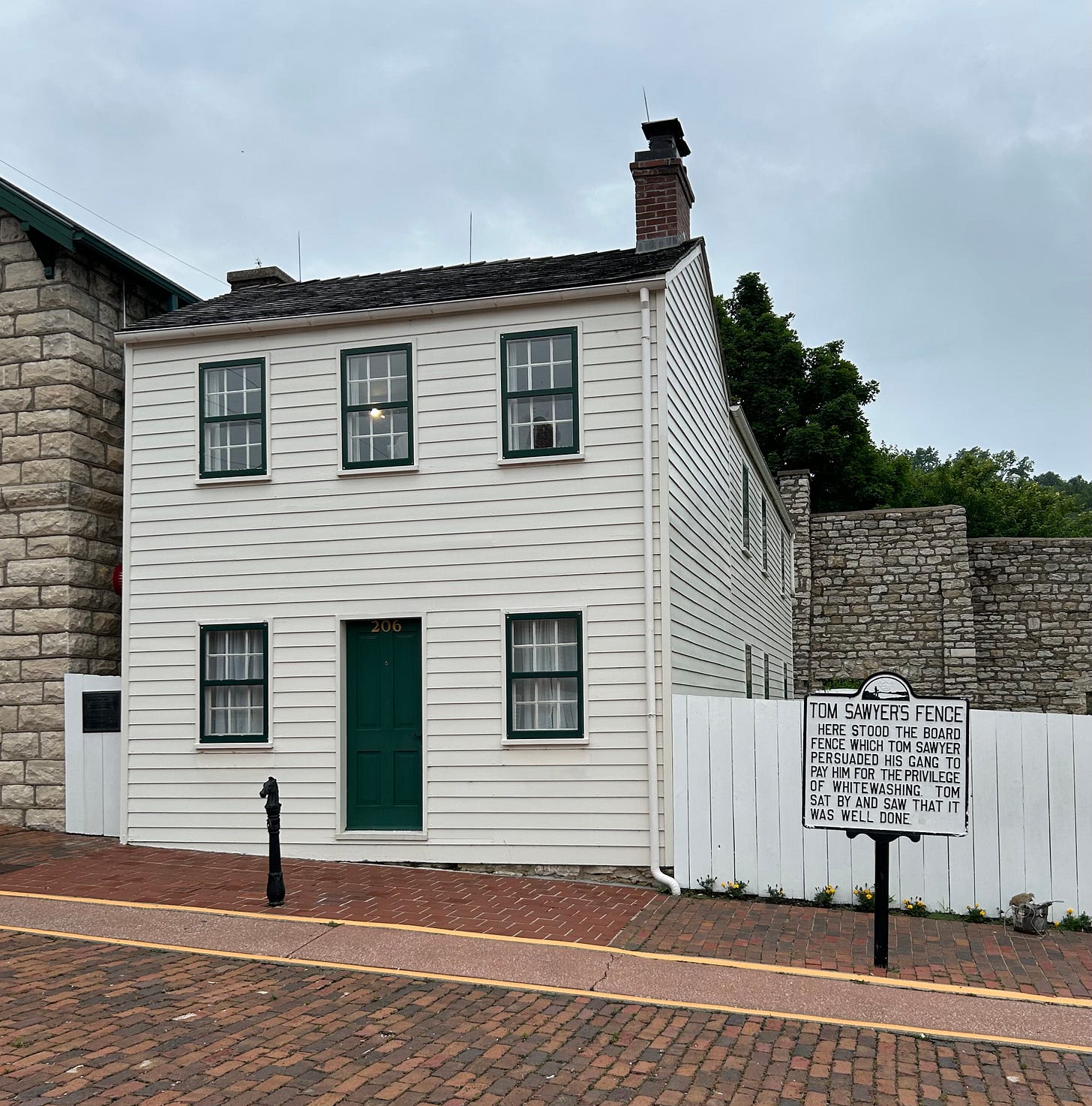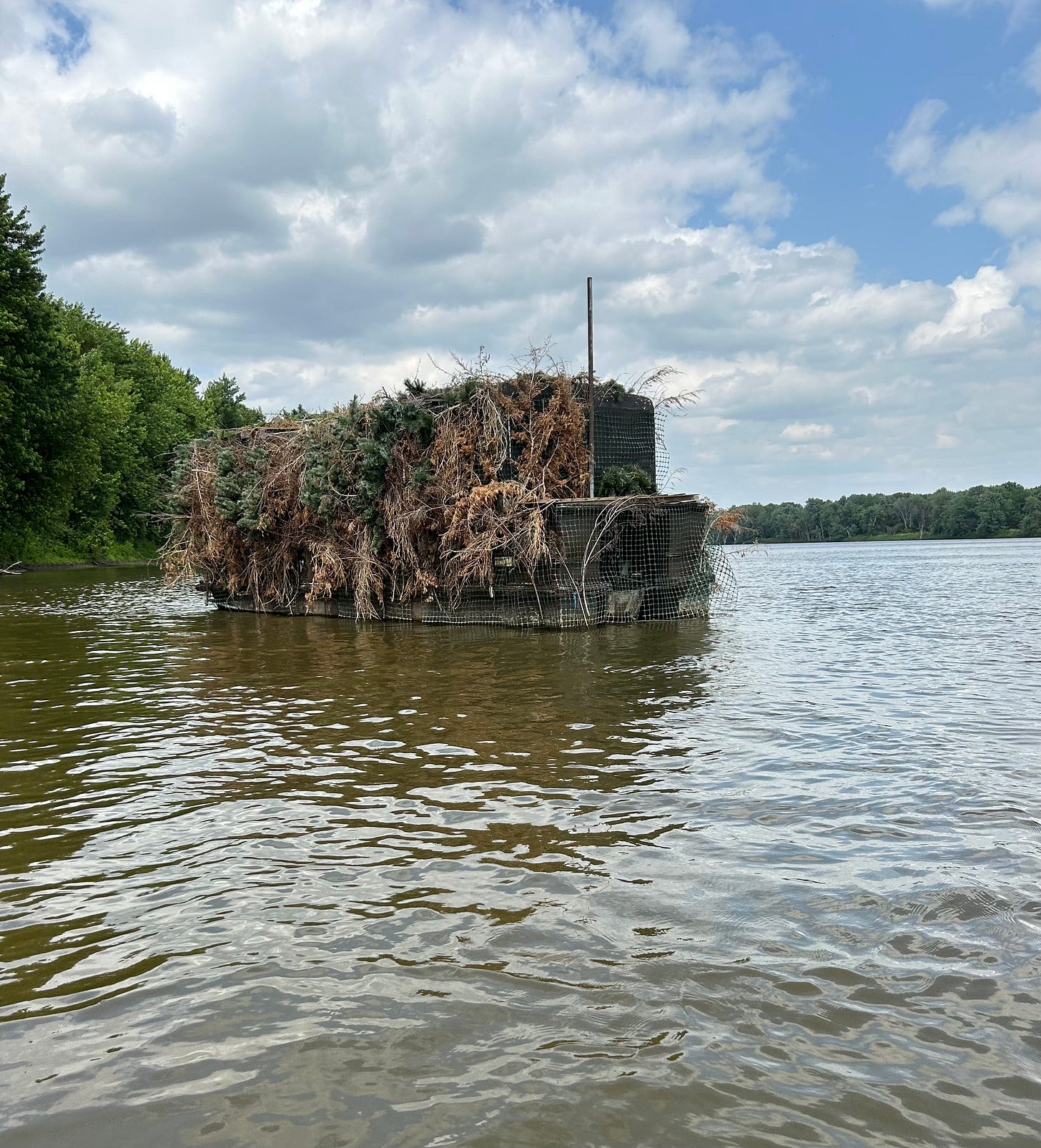Hannibal, Missouri
Skippin' in the Mississippi dew...
I’m sending this from Hannibal, Missouri. Since my last report from the Sunset Marina in Rock Island, Illinois, I covered 171 miles. Tomorrow I’ll be paddling to Louisiana - that’s Louisiana, Missouri.
The river is full of surprises.
My first stop after I left Sunset Marina was 18 miles down the river at Muscatine, Iowa. I was at the marina when a man got off his Harley and called down to me, “Are you a through paddler?” I told him I was. He said, “Do you need anything.” I told him I was looking for a place to tie up my rig so I could find a hotel for the night. He told me he could help and offered to go home and get his Jeep with a canoe rack and look after it for the night. He came back, we loaded the canoe and my gear, and he drove me to a hotel. The next morning he picked me up and dropped me back at the river. Unbelievable.
In the first half of the last century, Muscatine was known as the "Pearl of the Mississippi." In 1884, J. F. Boepple, a German immigrant, founded a button company that produced buttons that looked like pearls by machine-punching them from freshwater mussel shells harvested from the Mississippi River.
In 1915, Weber & Sons Button Co., Inc. was the world's largest producer of fancy freshwater pearl buttons, and along with the prominent McKee Button Company, Muscatine soon became "The Pearl Button Capital of the World."
A little further downriver is Fort Madison, Iowa, where in 1888 the first locomotive crossed the Mississippi River. Mexican immigrants fleeing the unrest of Mexico’s Revolutionary War became laborers on the railway. This gave birth to Old Santa Fe Town by the rail yards - the oldest Mexican settlement in Iowa. In 1910, the Atchison, Topeka, and Santa Fe Railway Depot was built using the Santa Fe style of architecture, which was the inspiration for Walt Disney’s depot in Disneyland. A young Disney worked on the train that traveled between his hometown in Marceline, Missouri, and Fort Madison, selling newspapers and snacks to travelers.
As I paddle down the river I often entertain myself by singing a song by John Hartford. In 1967, he wrote and recorded one of my favorite songs, Gentle on My Mind:
It was his most successful song and won four Grammy Awards.
Hartford was born on December 30, 1937, in New York City but spent his childhood in St. Louis, Missouri, where the Mississippi River influenced and shaped much of his career and music. From the time he got his first job on the river, at age 16, Hartford was on, around, or singing about the river. He graduated from Washington University in St. Louis and in 1965 moved to Nashville. In 1966, he signed with RCA Victor and the same year produced his first album, Looks at Life:
This is an excellent debut album. The Tall Tall Grass has provided me with much comfort over the years, particularly in recent months - almost too hard to listen to now:
As the story goes, in 1966, John Hartford lived with his wife and son in a trailer in Nashville, Tennessee. One night, the couple went to a local theater to see the film Doctor Zhivago. Inspired by the love story between Yuri Zhivago and Lara Antipova, he returned home and wrote the song in about thirty minutes.
It was released on his second studio album, Earthwords & Music.
However, I’m sure most people know more about Glen Campbell’s hit cover of Gentle on My Mind than about the man who wrote the song. Like everyone else, I had heard the song on the radio and thought Glen Campbell wrote it.
When I was in college in the early 1980s, a folk singer friend of mine, who knew I was a tap dancer, told me about John Hartford - the fiddle-playing tap dancer. She sent me a home-made cassette tape of his 1976 album Mark Twang:
Here’s the back cover:
I fell in love with this album, which spoke to the hobo in me and my affinity for the Mississippi River. From the album, here he is fiddlin’ and tappin’ to Skippin in the Mississippi Dew:
In the 1970s, Hartford earned his steamboat pilot's license, which he used to keep close to the river he loved. For many years during the summers, he worked as a pilot on the steamboat Julia Belle Swain, which he wrote about in this song:
As I mentioned last week, the Julia Belle Swain was the last steam-powered sternwheeler built by Dubuque Boat & Boiler Works. He also worked as a towboat pilot on the Mississippi, Illinois, and Tennessee Rivers.
In the late 1950s, Hartford recorded a wonderful session with Missouri fiddler Gene Goforth, who Hartford considered a significant influence. Goforth’s 1987 recordings with Dr. Howard W. Marshall in Hannibal, Missouri, capture the essence of his style and the rich tradition of Missouri fiddle music. However, Hannibal, Missouri is most known as the boyhood home of Mark Twain.
Mark Twain was raised in Hannibal and the town later inspired the creation of both his works Tom Sawyer and Huckleberry Finn.
The Adventures of Tom Sawyer (also known as Tom Sawyer), published on June 9, 1876, is about a boy, Tom Sawyer, growing up along the Mississippi River. It is set in the 1840s in the town of St. Petersburg, which is based on Hannibal. Tom grows bored with school, and he, his friend and classmate Joe Harper, and Huck Finn run away to Jackson's Island on the Mississippi River to begin life as "pirates."
Adventures of Huckleberry Finn is a direct sequel to The Adventures of Tom Sawyer. Huck becomes very close to Jim when they reunite after Jim flees Miss Watson's household to seek refuge from slavery. Huck and Jim become fellow travelers on the Mississippi River.
Published in 1883, Life on the Mississippi is Twain’s memoir of his days as a steamboat pilot on the Mississippi River before the American Civil War. In the second half, Twain narrates his trip many years later on a steamboat from St. Louis to New Orleans, shortly followed by a steamboat journey from New Orleans to St Paul (with a stop at his boyhood hometown of Hannibal). Here’s a picture of the house where Twain grew up:
The Mississippi above Hannibal is full of side channels that meander along the main channel, like Deandmans slough and Otter chute. When it was windy, I’d use these to get a break from the wind. This is where the dark backwaters flow, not even marked on The US Army Corps of Engineers maps I use. If things go wrong in there, no one would ever find you and the catfish would eat you.
In the side channels is where the snakes hang out:
…and where custom catfish poles are lodged into trees hanging out along the banks:
…and where spooky duck blinds creak as you go by:
But these side channels are teaming with life: beautifully colored songbirds, great blue herons, bald eagles, the scattered flowering tree, fish jumping out of the water, and the dreaded poisin ivy that grows everywhere like grass. It is a world where beauty and danger live side by side.
Twain summed up this beauty well in Life on the Mississippi:
Then a bird pipes up, another follows, and soon the pipings develop into a jubilant riot of music. You see none of the birds; you simply move through an atmosphere of song which seems to sing itself.
Shortly before his death, the great Argentine novelist Jorge Luis Borges made a literary pilgrimage to Hannibal to pay homage to Mark Twain. Meticulously dressed in a three-piece suit, the blind octogenarian arrived in town and was escorted to the Mississippi River levee. Suddenly, to the surprise of everyone, he began walking trance-like into the muddy waters until the river rushed up to his chest. He said, “Now, I understand the essence of America.”
Next week, I hope to be reporting from somewhere around St. Louis. Only 4 more locks to go.
Your true pilot cares nothing about anything on earth but the river, and his pride in his occupation surpasses the pride of kings.
-Mark Twain
Please hit this link to buy me a cup of coffee, if you’d like to show your guide some appreciation for this and past journeys. Know in advance that I thank you for your kindness and support.
If you like what you’ve been reading and hearing so far on our journey and would like to share this with someone you think might be interested in learning more about our great American art form, Jazz, just hit the “Share” button.
From Astaire to Sun Ra: A Jazz Journey is a reader-supported publication. If you feel so inclined, subscribe to my journey by hitting the “Subscribe now” button.
Also, find my playlist on Spotify: From Fred Astaire to Sun Ra.
Feel free to contact me at any time to talk shop. I welcome and encourage that.
Until then, keep on walking….












I loved this read from first word to the last.
I will say that, that photo of the fat pile of Water Moccasins sunning just gives me the all over fidgets.
Beautiful, Tyler. Another post, strong with emotion, your specialty.